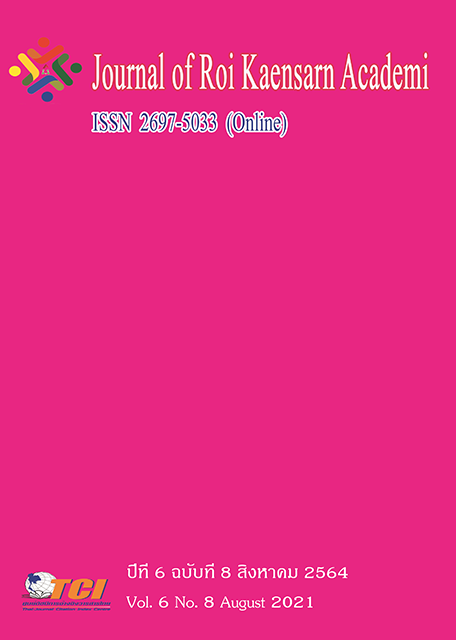Construction of Executive Function (EF) Skill Test in Basic skills for Pratomsuksa 6 Students in Nakhon Phanom Province
Main Article Content
Abstract
The purposes of this research were 1) to develop the indicators of Executive Functions (EF) Skill Test in Basic skills for Pratomsuksa 6 Students in Nakhon Phanom Province. 2) to create the measurement and find the qualitative of Executive Functions (EF) Skill Test in Basic skills for Pratomsuksa 6 Students in Nakhon Phanom Province. The sample groups were 630 students in Prathom Suksa 6, semester 2, academic year 2018 from 40 schools in Nakhon Phanom Primary Educational Service Area Office 1. The sample group of the study was selected by using Stratified Random Sampling. The research tools used in this study were 1) the measurement of Executive Functions (EF) Skill Test in Basic skills for 33 items. which had IOC value (Item – Objective Congruence) between 0.60 – 1.00. The Data were analysis by using the discrimination for the total Item - total correlation, the reliability was used in Cronbach’s alpha coefficient (α) and the validity was used in confirmatory factor analysis. The results of the study were as follows
1.There are 3 main elements, 6 sub-elements and 33 indicators in the executive functions skill in basic skills as follows: 1) The element of Working Memory has 2 sub-elements as follows 1.1) take the information into long-Term Memory in order to be able to remember and do it later which included with 7 indicators. 1.2) Attention is included with 4 indicators. 2) The element of Inhibitory Control has 2 sub-elements as follows 2.1) Emotional Control is included with 5 indicators. 2.2) Thinking and making choices that essential to be success, it is including with 6 indicators. 3) The element of Cognitive Flexibility has 2 sub-elements as follows: 3.1) the modification of thinking, changing perspective, it is including with 6 indicators. 3.2) Solving problems in a variety of ways, it is including with 5 indicators.
2.The measurement of Executive Functions (EF) Skill Test in Basic skills was characterized by 5 level rating scale for 33 items which have discrimination) (rxy) values ranging from 0.421 to 0.762. The reliability (α) value is 0.947. The construct validity considers by the suitable of the model (Goodness of fit indices) suitable for every value as follows: Chi - Square= 2.866, df= 6, /df= 0.477, p-value = 0.825, CFI=1.000, TLI = 1.000, RMSEA=0.000 และ SRMR = 0.006
Article Details
References
กัลยา วานิชย์บัญชา. (2549). การวิเคราะห์สถิติขั้นสูงด้วย SPSS for Windows. (พิมพ์ครั้งที่ 5). กรุงเทพมหานคร: โรงพิมพ์แห่งจุฬาลงกรณ์มหาวิทยาลัย.
จามรี ศรีรัตนบัลล์ และคณะ. (2559). ผลของความสามารถในการคิดแก้ปัญหาด้านทักษะสังคม เรื่องการถูกแกล้งสำหรับนักเรียนในระดับประถมศึกษาตอนปลาย. วารสารศิลปศาสตร์ มหาวิทยาลัยสงขลานครินทร์สงขลานครินทร์ วิทยาเขตหาดใหญ่. 8 (2), 161-187.
จุฬินฑิพา นพคุณ. (2561). การพัฒนาทักษะสมองเพื่อชีวิตที่สำเร็จในศตวรรษที่ 21 สำหรับเด็กปฐมวัยผ่านการสอนแบบมอนเตสซอรี่. วารสารศึกษาศาสตร์ มหาวิทยาลัยศิลปากร. 16 (1), 75–90.
นวลจันทร์ จุฑาภักดีกุล และคณะ. (2560). การพัฒนาและการหาค่าเกณฑ์มาตรฐานเครื่องมือประเมินการคิดเชิงบริหารในเด็กปฐมวัย. กรุงเทพมหานคร: ศูนย์วิจัยประสาทวิทยาศาสตร์ สถาบันชีววิทยาศาสตร์โมเลกุล มหาวิทยาลัยมหิดล
โรงเรียนเพลินพัฒนา. (2558). EF ทักษะสมองเพื่อชีวิตที่สำเร็จ...ในวัยอนุบาล. ออนไลน์. สืบค้นเมื่อ 12 ตุลาคม 2561. แหล่งที่มา: http://www.plearnpattana.ac.th/m465/index.php?option= com_content&task=view&id=3992&Itemid=132.
ล้วน สายยศ และ อังคณา สายยศ. (2553). เทคนิคการวิจัยทางการศึกษา. (พิมพ์ครั้งที่ 11). กรุงเทพมหานคร: สุวีริยาสาส์น.
ศิริชัย กาญจนวาสี. (2548). ทฤษฎีการประเมิน. กรุงเทพมหานคร: จุฬาลงกรณ์มหาวิทยาลัย.
สมบัติ ท้ายเรือคำ. (2552). สถิติขันสูงสำหรับการวิจัยทางการศึกษา (Advanced Statistics for Educational). มหาสารคาม: คณะศึกษาศาสตร์ มหาวิทยาลัยมหาสารคาม.
สำนักงานวิชาการและมาตรฐานการศึกษา. (2558). ตัวชี้วัดและสาระการเรียนรู้สุขศึกษาและพลศึกษา
ตามหลักสูตรแกนกลางการศึกษาขั้นพื้นฐาน พุทธศักราช 2551. ออนไลน์. สืบค้นเมื่อ 28 สิงหาคม 2561. แหล่งที่มา: http://academic.obec.go.th /newsdetail.php?id=75.
